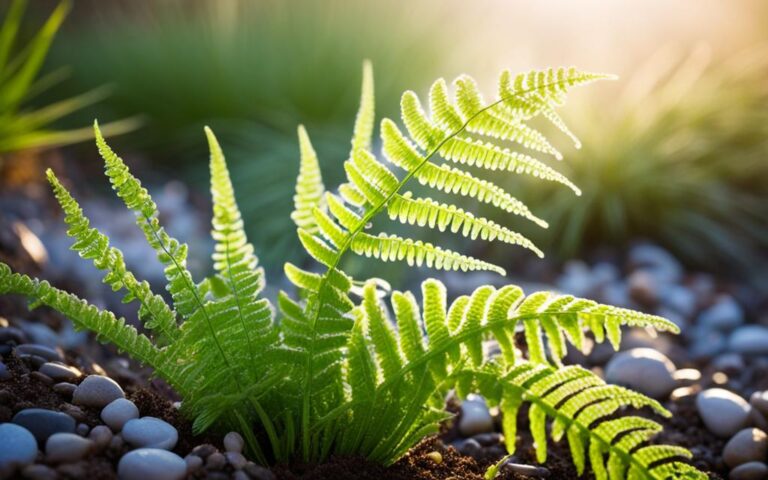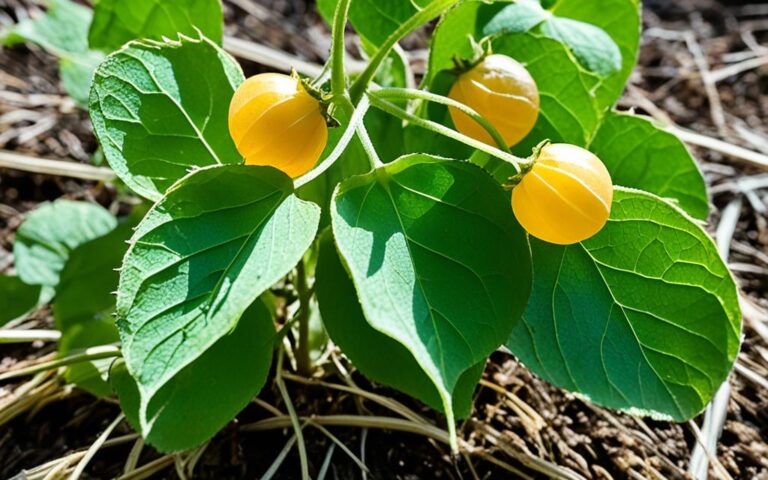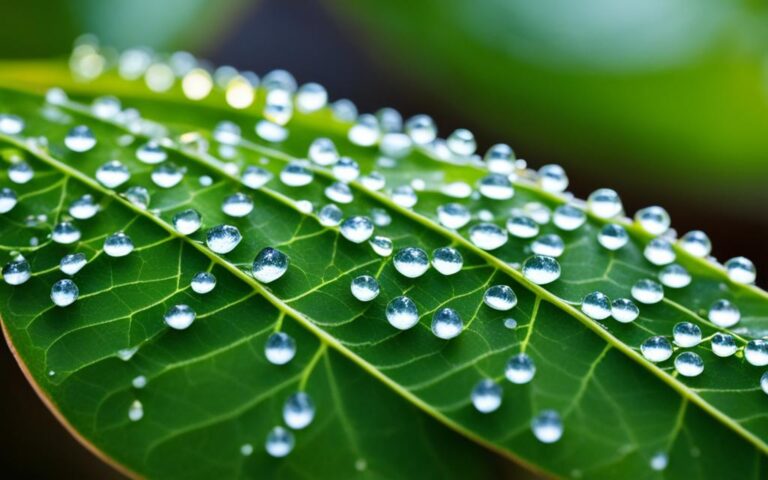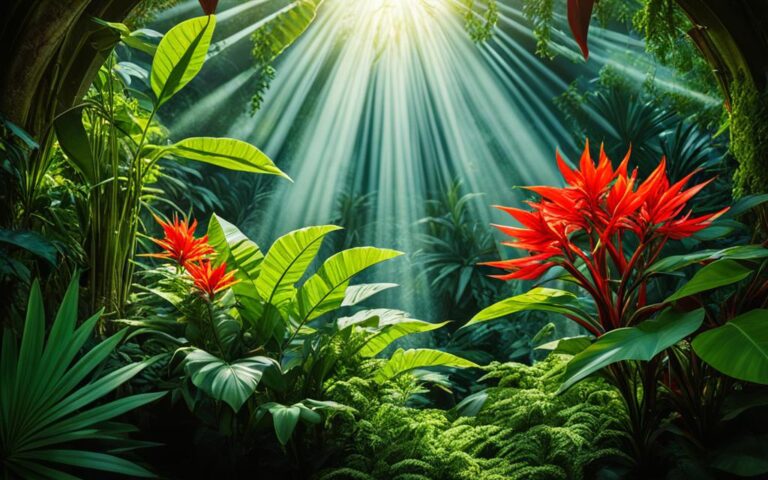Tropical Pitcher Plant: Nature’s Living Traps
A healthy tropical pitcher plant, or Nepenthes, can fill its pitcher with digestive fluid up to 15% of its size. These plants, found in the lush rainforests of Southeast Asia, Australia, and parts of Africa and South America, catch and eat insects and small animals. They do this to get nutrients in poor soil.
Key Takeaways
- Tropical pitcher plants, or Nepenthes, are a unique group of carnivorous plants found in tropical regions.
- These plants have specialized pitcher-shaped leaves that are adapted to trap, digest, and absorb nutrients from insects and other small animals.
- Healthy Nepenthes pitchers can contain digestive fluid filling up to 15% of the pitcher’s volume.
- Factors like inadequate water, humidity, or light can affect the pitcher plant’s ability to produce fluid and trap prey.
- Nepenthes plants typically start producing fluid in their pitchers within a month or two of acclimating to a new environment.
Introduction to the Tropical Pitcher Plant
The tropical pitcher plant is part of the Nepenthes genus. It’s a group of carnivorous plants found in the tropics around the world. These plants have leaves shaped like pitchers. They use these leaves to catch and digest insects and small animals for nutrients.
There are about 170 known species of Nepenthes. Most are found on islands like Borneo, Sumatra, and the Philippines. These plants love the hot, humid, and high places they live in. They show how well they can adapt to their environments.
Nepenthes plants make two kinds of pitchers. Each type has a different job in catching prey. This special feature helps the plants survive and stand out in nature.
“The tropical pitcher plant is a true testament to the ingenuity and resilience of nature, showcasing the remarkable adaptations that allow these plants to thrive in their unique environments.”
Tropical pitcher plants are not just interesting to look at. They also have unique ways of surviving. As we learn more about them, we see how they’ve evolved and adapted over time. They play a big part in the balance of tropical ecosystems.
Unique Characteristics of Carnivorous Pitcher Plants
Carnivorous pitcher plants, like those in the Nepenthes genus, have evolved special traits. These traits help them catch and digest their prey. Their leaves are shaped like pitchers and have different parts that aid in hunting.
Anatomy and Mechanisms of Prey Capture
The top of the pitcher has glands that make nectar and a slippery surface. This makes insects slip and fall into the trap’s liquid part. The liquid inside the pitcher helps break down and absorb nutrients from the insects.
Diverse Array of Pitcher Plant Varieties
The Nepenthes genus includes many species, each with its own pitcher shape, size, and color. This shows how well they adapt to their environments. From the tall Nepenthes attenboroughii to the underground Nepenthes pudica, they vary greatly.
| Pitcher Plant Family | Number of Species | Distribution |
|---|---|---|
| Sarraceniaceae | Approximately 3 genera | North America, western Guiana Highlands |
| Cephalotaceae | 1 species | Western Australia |
| Heliamphora | Around 23 species | Rainforest mountains of Brazil, Guyana, and Venezuela |
| Nepenthaceae | Approximately 140 species | Tropical regions of Asia and Australia |
Scientists are still learning about these carnivorous plants. They find new species and study how they survive in their environments.
Origin and Habitats of Tropical Pitcher Plants
Tropical pitcher plants, part of the Nepenthes genus, come from many tropical areas worldwide. Most live in Southeast Asia, especially on Borneo and Sumatra. They also grow in Australia, parts of South America, and the Indian Ocean islands.
These plants love poor, humid soil and often live on trees or in poor soil. Out of 104 Nepenthes species, 63 are at risk, with 9 facing a high risk of extinction.
The Nepenthes carunculata is one example from Sumatra, Indonesia. It needs both male and female plants to reproduce, showing the wide variety of these plants.
| Region | Pitcher Plant Species | IUCN Status |
|---|---|---|
| Southeast Asia | Nepenthes spp. | 63 Vulnerable or Endangered, 9 Critically Endangered |
| Australia | Nepenthes spp. | Not specified |
| South America | Nepenthes spp. | Not specified |
| Indian Ocean Islands | Nepenthes spp. | Not specified |
Tropical pitcher plants live in various places, from lowlands to high mountains. Some even grow up to 11,500 feet high. Their beauty and adaptability make them popular in gardens and terrariums.
While most grow in the wild, many Nepenthes hybrids are grown in gardens. These hybrids come in many colors and shapes, pleasing gardeners and fans.
The Pitcher Fluid: A Deadly Yet Nurturing Environment
Tropical pitcher plants have a complex ecosystem inside their pitchers. The pitcher fluid is key to their carnivorous nature. It’s made by the plant in some Nepenthes species and from rainwater in others.
Composition and Sources of the Pitcher Fluid
The fluid is acidic and full of oxygen, with digestive enzymes to break down prey. Different Nepenthes species have unique fluid compositions. This affects how they catch prey and support other living things in their traps.
Physical Factors Affecting the Fluid
The fluid’s viscosity, pH, and oxygen levels change with the species and environment. These changes are crucial for the plant’s carnivorous success and its relationships with other creatures.
| Nepenthes Species | Pitcher Fluid Characteristics | Prey Capture Strategy |
|---|---|---|
| Nepenthes veitchii | Highly acidic, viscous fluid | Effective at trapping and digesting a wide range of insects and small animals |
| Nepenthes alata | Less acidic, more watery fluid | Specializes in capturing and digesting ants and other small arthropods |
| Nepenthes rafflesiana | Fluid with varying oxygen levels | Attracts a diverse array of inquiline species that contribute to its prey-capture abilities |
The pitcher fluid’s complex makeup shows how these carnivorous plants have adapted over time. They can live in many places and interact with the world in fascinating ways.
Inquiline Diversity in Pitcher Plants
Tropical pitcher plants are known for eating insects but also host many other organisms. These include bacteria, protozoa, algae, fungi, and even amphibians. Most of these visitors are protists and dipteran larvae.
Not all pitcher plants have the same number of visitors. Some have a few, while others, like Sarracenia purpurea, have up to 165 different visitors. The type of visitors depends on the plant’s pitcher fluid.
| Pitcher Plant Species | Approximate Number of Inquiline Species |
|---|---|
| Nepenthes sp. | Up to 59 species |
| Sarracenia purpurea | Up to 165 species |
| Vriesea sp. Bromeliads | Up to 70 species |
Studies show that the pitcher fluid’s pH, viscosity, and color affect the microbes inside. Nepenthes species create unique microbial communities, even under similar conditions.
The variety of visitors in pitcher plants shows how complex these ecosystems are. Learning about these relationships helps us understand tropical ecosystems better.
Mutualistic Relationships Between Pitcher Plants and Inquilines
Tropical pitcher plants and their inquiline friends have a mutualistic relationship. This means they help each other out. The inquilines do things that are good for the plants, like helping them get nutrients and stay healthy.
Beneficial Activities of Inquilines
Inquilines live inside the pitcher plants and do important jobs. They help the plants in several ways:
- Secretion of digestive enzymes: Some inquilines, like bacteria and insects, make enzymes. These enzymes help break down the trapped prey. This makes the nutrients easier for the plant to use.
- Breakdown and utilization of prey: Many inquilines eat and degrade the prey the pitcher plant catches. This helps with nutrient cycling in the plant’s world.
- Removal of excessive prey: If the pitcher plant catches too much prey, inquilines help clean it out. This stops the buildup of prey degradation stuff that could hurt the plant.
- Assimilation of atmospheric nitrogen: Some inquilines, like nitrogen-fixing bacteria, turn air nitrogen into a form the plant can use. This boosts the plant’s nutrient acquisition skills.
This shows how pitcher plants and their inquiline friends work together. They have a special symbiosis that helps them both.
“The inquiline communities play a crucial role in the plant’s nutrient acquisition, as they help to degrade and process the trapped prey, which the plant then absorbs.”
Tropical Pitcher Plant: A Captivating Addition to Any Garden
The tropical pitcher plant is a stunning choice for any garden or indoor spot. These plants help control pests naturally and add an exotic feel to gardens. They need special care but can flourish with the right conditions, becoming a highlight in gardens.
The “Savage Gardens” exhibit is a great way to see these plants. It runs from July 1st to October 29th. Visitors can see a giant Fanged Pitcher Plant Nepenthes and an interactive Venus Flytrap. On select weekends, you can buy different carnivorous plants, including tropical pitcher plants.
Pitcher plants, or Sarracenia, are fascinating because they eat insects for nutrients. There are many types, like the Sarracenia purpurea, Sarracenia flava, and Sarracenia leucophylla. Each type looks different and has its own needs, making it easy to find one for your garden.
| Variety | Visual Appeal | Growth Preferences |
|---|---|---|
| Sarracenia purpurea (Purple Pitcher Plant) | Vibrant purple, red, and green pitchers | Tolerates more shade and cooler temperatures |
| Sarracenia flava (Yellow Pitcher Plant) | Bright yellow pitchers with red veining | Requires more sunlight and warmer conditions |
| Sarracenia leucophylla (White-topped Pitcher Plant) | Distinctive white-topped pitchers with red accents | Thrives in humid, well-drained environments |
With proper care, tropical pitcher plants can be a beautiful addition to any space. They offer a unique and exotic touch. By knowing what they need, gardeners can enjoy these plants for many years.
Cultural Significance and Symbolism
The tropical pitcher plant is very important in many cultures. In places like South Africa, the Xhosa people see its leaves as medicine. Artists and writers love its unique look, using it in their work.
In Asia, the Nepenthes plant is a symbol of good luck during Lunar New Year. It’s thought to bring wealth and happiness. Its strange look and how it eats insects has led to stories and legends.
Art, Literature, and Spiritual Connections
- Artists show the Pitcher Plant in their work, like paintings and sculptures, because it looks so interesting.
- Writers have used the Pitcher Plant in stories and poems. They talk about its meaning and its place in nature.
- People all over see the Pitcher Plant as spiritually important. It stands for things like being strong, safe, and connected to nature.
“The Pitcher Plant, with its graceful form and carnivorous nature, has long captured the imagination of artists, writers, and spiritual practitioners alike. Its unique place in the natural world reflects the complexity and wonder of our shared existence.”
The tropical pitcher plant is still celebrated for its cultural and symbolic value. It shows how plants affect our creativity, spirituality, and how we see the world.
Cultivating and Caring for Tropical Pitcher Plants
Raising tropical pitcher plants, like the Nepenthes species, is rewarding for gardeners and plant lovers. These plants need high humidity, well-draining, nutrient-poor soil, and lots of indirect light. It’s important to water them right and not overfeed them.
Ideal Growing Conditions
Tropical pitcher plants like Nepenthes do best in a temperature range of 70-80°F (21-27°C) during the day. They like a 15°F (8°C) drop at night. They need high humidity, keeping it at least 60%.
Good air circulation is key to prevent trap browning. They also need well-draining, nutrient-poor soil. A mix of peat, sand, perlite, fir bark, and sphagnum moss works well.
These plants love bright, indirect light. They need at least 6 hours of light each day. You can use a sunny windowsill or grow lights to help them.
Propagation and Maintenance
You can grow pitcher plants through seed sowing, division, and stem cuttings. They grow slowly, taking 5-10 years to mature. But once they start growing, they speed up.
Regular pruning and pest management keep them healthy and looking good.
| Cultivation Requirement | Ideal Condition |
|---|---|
| Temperature | 70-80°F (21-27°C) day, 15°F (8°C) cooler at night |
| Humidity | Minimum 60% relative humidity |
| Soil | Well-draining, nutrient-poor mix (1:1:1:1:1 peat:sand:perlite:fir bark:sphagnum) |
| Light | Bright, indirect light for at least 6 hours per day |
| Watering | Keep soil consistently moist, but avoid overwatering |
| Propagation | Seed sowing, division, stem cuttings |
| Maintenance | Regular pruning, pest management |
By giving them the right growing conditions, propagation methods, and maintenance practices, gardeners can grow these tropical pitcher plants. They add a touch of natural wonder to any space.
Ecological Importance of Pitcher Plants
Tropical pitcher plants are key to their ecosystems. They act as natural pest controllers and air purifiers. These plants can trap and digest insects and small animals. This makes them a great way to control pests without harming the environment.
They also clean the air by absorbing pollutants. This helps improve the air quality around them.
Natural Pest Control and Air Purification
A study by a team at the National University of Singapore found something interesting about pitcher plants. Led by Associate Professor Hugh Tan, the research showed that a certain hoverfly helps pitcher plants. This hoverfly, Nepenthosyrphus, makes the plants better at recycling nutrients.
Before, people thought this hoverfly would hurt the plants by eating the flies that help them. But the study found the opposite is true. The hoverfly actually helps the plants by improving how well they recycle nutrients.
| Ecological Benefits of Pitcher Plants | Key Findings |
|---|---|
| Natural Pest Control | Pitcher plants effectively trap and digest a variety of insects and small animals, reducing the presence of unwanted pests. |
| Air Purification | Pitcher plants have the ability to absorb pollutants from the air, contributing to improved air quality in their surrounding environments. |
| Nutrient Cycling Efficiency | The presence of predatory hoverfly larvae, such as Nepenthosyrphus, can significantly enhance the nutrient-cycling efficiency of pitcher plants. |
These plants are not just beautiful; they are also crucial for their ecosystems. They help control pests, purify the air, and recycle nutrients. This shows how important they are for the environment.
Fascinating Facts About Tropical Pitcher Plants
Tropical pitcher plants, part of the Nepenthes genus, are truly fascinating. They have amazing adaptations and unique traits. Some can hold up to 1.5 liters of fluid in their pitchers. Others have evolved to attract insects with their vibrant colors and patterns.
The variety in pitcher shapes and sizes across the Nepenthes genus shows nature’s creativity. Nepenthes thrive in places like Borneo, Sumatra, and the Philippines. Over 100 species show off their diversity, each with its own set of characteristics.
It’s interesting to know that Nepenthes fossils from about 35 million years ago have been found. This shows how long these carnivorous plants have been around. Many Nepenthes species have formed special bonds with ants. These ants live in the pitchers and help the plant by providing nutrients in return for a safe home.
| Nepenthes Adaptations | Optimal Growing Conditions |
|---|---|
|
|
Despite their interesting traits, many Nepenthes species face threats like habitat loss. Some are even endangered. As we learn more about these plants, we appreciate their diversity and resilience even more.
Embracing the Exotic Beauty of Nature’s Living Traps
The tropical pitcher plant is a true marvel of nature. It has a captivating look and fascinating ways to survive. These plants are a big part of the amazing diversity in nature. They catch the eye of gardeners, scientists, and everyone who loves nature.
Nepenthes pitcher plants, also called “monkey cups,” have unique pitchers that trap and digest insects. This helps control pests naturally. They also act as air filters, cleaning the air by trapping pollutants. These plants are easy to care for and do well in poor soil, making them perfect for gardens.
In some places, these plants have special meanings. Nepenthes ventricosa is seen as a symbol of wealth and good luck during Lunar New Year. It’s also used in traditional medicine, showing its importance in local cultures.
“Engaging with Nepenthes pitcher plants encourages sustainable practices, like using eco-friendly fertilizers and recycling plant containers, contributing to a greener planet and emphasizing the importance of sustainable living.”
By loving these exotic natural wonders, we connect more with nature and learn about ecosystems. Growing Nepenthes helps us understand the value of biodiversity. It also leads to projects like education and conservation efforts, helping protect these plants.
The interest in Nepenthes and other carnivorous plants is growing. This means we need to focus more on conservation and sustainable cultivation. By taking care of these exotic beauties, we celebrate our planet’s diversity. We also help protect the future of our natural wonders.
Conclusion
Tropical pitcher plants, or Nepenthes, are nature’s amazing carnivores. They have leaves shaped like pitchers to catch and digest insects. These plants show how nature adapts and thrives in unique ways.
These plants are not just beautiful but also important for their ecosystems. They help control pests, clean the air, and support many other species. By saving these plants, we help keep our planet healthy for the future.
As we finish learning about tropical pitcher plants, let’s think about why we need to protect nature. We must keep studying, growing, and respecting these plants. This way, we can learn more about Nepenthes and their role in our world.






